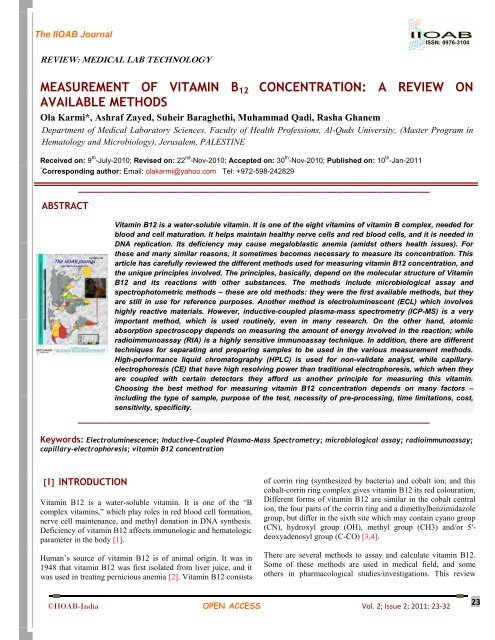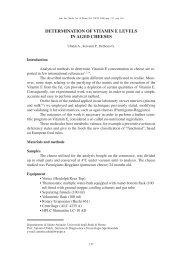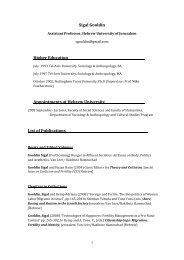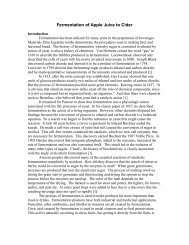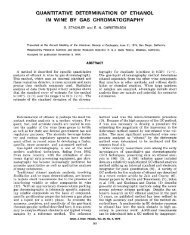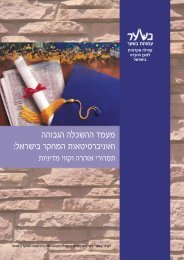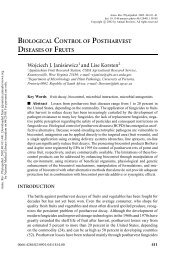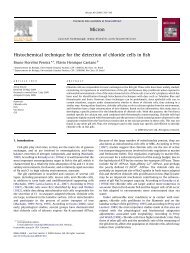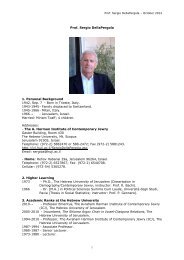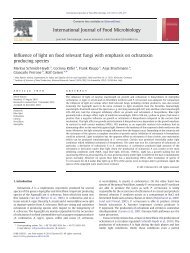available methods to measure vitamin b12 - The IIOAB Journal
available methods to measure vitamin b12 - The IIOAB Journal
available methods to measure vitamin b12 - The IIOAB Journal
You also want an ePaper? Increase the reach of your titles
YUMPU automatically turns print PDFs into web optimized ePapers that Google loves.
<strong>The</strong> <strong>IIOAB</strong> <strong>Journal</strong><br />
ISSN: 0976-3104<br />
REVIEW: MEDICAL LAB TECHNOLOGY<br />
MEASUREMENT OF VITAMIN B 12 CONCENTRATION: A REVIEW ON<br />
AVAILABLE METHODS<br />
Ola Karmi*, Ashraf Zayed, Suheir Baraghethi, Muhammad Qadi, Rasha Ghanem<br />
Department of Medical Labora<strong>to</strong>ry Sciences, Faculty of Health Professions, Al-Quds University, (Master Program in<br />
Hema<strong>to</strong>logy and Microbiology), Jerusalem, PALESTINE<br />
Received on: 9 th -July-2010; Revised on: 22 nd -Nov-2010; Accepted on: 30 th -Nov-2010; Published on: 10 th -Jan-2011<br />
* Corresponding author: Email: olakarmi@yahoo.com Tel: +972-598-242829<br />
ABSTRACT<br />
_____________________________________________________<br />
Vitamin B12 is a water-soluble <strong>vitamin</strong>. It is one of the eight <strong>vitamin</strong>s of <strong>vitamin</strong> B complex, needed for<br />
blood and cell maturation. It helps maintain healthy nerve cells and red blood cells, and it is needed in<br />
DNA replication. Its deficiency may cause megaloblastic anemia (amidst others health issues). For<br />
these and many similar reasons, it sometimes becomes necessary <strong>to</strong> <strong>measure</strong> its concentration. This<br />
article has carefully reviewed the different <strong>methods</strong> used for measuring <strong>vitamin</strong> B12 concentration, and<br />
the unique principles involved. <strong>The</strong> principles, basically, depend on the molecular structure of Vitamin<br />
B12 and its reactions with other substances. <strong>The</strong> <strong>methods</strong> include microbiological assay and<br />
spectropho<strong>to</strong>metric <strong>methods</strong> – these are old <strong>methods</strong>: they were the first <strong>available</strong> <strong>methods</strong>, but they<br />
are still in use for reference purposes. Another method is electroluminescent (ECL) which involves<br />
highly reactive materials. However, inductive-coupled plasma-mass spectrometry (ICP-MS) is a very<br />
important method, which is used routinely, even in many research. On the other hand, a<strong>to</strong>mic<br />
absorption spectroscopy depends on measuring the amount of energy involved in the reaction; while<br />
radioimmunoassay (RIA) is a highly sensitive immunoassay technique. In addition, there are different<br />
techniques for separating and preparing samples <strong>to</strong> be used in the various <strong>measure</strong>ment <strong>methods</strong>.<br />
High-performance liquid chroma<strong>to</strong>graphy (HPLC) is used for non-validate analyst, while capillaryelectrophoresis<br />
(CE) that have high resolving power than traditional electrophoresis, which when they<br />
are coupled with certain detec<strong>to</strong>rs they afford us another principle for measuring this <strong>vitamin</strong>.<br />
Choosing the best method for measuring <strong>vitamin</strong> B12 concentration depends on many fac<strong>to</strong>rs –<br />
including the type of sample, purpose of the test, necessity of pre-processing, time limitations, cost,<br />
sensitivity, specificity.<br />
_____________________________________________________<br />
Keywords: Electroluminescence; Inductive-Coupled Plasma-Mass Spectrometry; microbiological assay; radioimmunoassay;<br />
capillary-electrophoresis; <strong>vitamin</strong> B12 concentration<br />
[I] INTRODUCTION<br />
Vitamin B12 is a water-soluble <strong>vitamin</strong>. It is one of the “B<br />
complex <strong>vitamin</strong>s,” which play roles in red blood cell formation,<br />
nerve cell maintenance, and methyl donation in DNA synthesis.<br />
Deficiency of <strong>vitamin</strong> B12 affects immunologic and hema<strong>to</strong>logic<br />
parameter in the body [1].<br />
Human’s source of <strong>vitamin</strong> B12 is of animal origin. It was in<br />
1948 that <strong>vitamin</strong> B12 was first isolated from liver juice, and it<br />
was used in treating pernicious anemia [2]. Vitamin B12 consists<br />
of corrin ring (synthesized by bacteria) and cobalt ion; and this<br />
cobalt-corrin ring complex gives <strong>vitamin</strong> B12 its red colouration.<br />
Different forms of <strong>vitamin</strong> B12 are similar in the cobalt central<br />
ion, the four parts of the corrin ring and a dimethylbenzimidazole<br />
group, but differ in the sixth site which may contain cyano group<br />
(CN), hydroxyl group (OH), methyl group (CH3) and/or 5'-<br />
deoxyadenosyl group (C-CO) [3,4].<br />
<strong>The</strong>re are several <strong>methods</strong> <strong>to</strong> assay and calculate <strong>vitamin</strong> B12.<br />
Some of these <strong>methods</strong> are used in medical field, and some<br />
others in pharmacological studies/investigations. This review<br />
©<strong>IIOAB</strong>-India OPEN ACCESS Vol. 2; Issue 2; 2011: 23-32<br />
23
<strong>The</strong> <strong>IIOAB</strong> <strong>Journal</strong><br />
focuses on some of the weaknesses and strengths of these<br />
<strong>methods</strong>, and aims <strong>to</strong> identify the best method for measuring the<br />
concentration of <strong>vitamin</strong> B12.<br />
[II] HISTORICAL TECHNIQUES<br />
2.1. Microbiological and spectropho<strong>to</strong>metric<br />
<strong>methods</strong><br />
Microbiological method is one of the oldest <strong>methods</strong> for<br />
measuring the concentration of <strong>vitamin</strong> B12. Information<br />
regarding this method has been extensively documented [5].<br />
Ross (1950) was the first scientist <strong>to</strong> describe microbiological<br />
method using Euglena gracilis var-bacillaris as test organism.<br />
<strong>The</strong>reafter there was introduction of Z strain of Euglena gracilis<br />
so as <strong>to</strong> shorten the growth period required for the test <strong>to</strong> as low<br />
a five days [6]. Further experiments on <strong>measure</strong>ment of <strong>vitamin</strong><br />
B12 focused on either changing microorganism test or<br />
developing test techniques, such as adding heating step or some<br />
substances <strong>to</strong> the test procedures for converting <strong>vitamin</strong> B12 <strong>to</strong><br />
the active free form [6]. Also, several microorganisms were<br />
proposed for the microbiological assay. <strong>The</strong>se <strong>methods</strong> include<br />
Euglena gracilis tube method, filter paper disc method (FPD),<br />
Escherichia coli tube method, plate method, Lac<strong>to</strong>bacillus<br />
leishmanii tube method, bioau<strong>to</strong>graphic method, and<br />
Ochromonas malhamensis tube method [7]. However, Euglena<br />
gracilis and Lac<strong>to</strong>bacillus leishmanii are the most commonly<br />
used <strong>methods</strong> [5,7,8].<br />
Davis et al [6] described a fully au<strong>to</strong>mated method for the<br />
microbiological <strong>measure</strong>ment of <strong>vitamin</strong> B12 using<br />
chloramphenicol-resistance strain of Lac<strong>to</strong>bacillus leishmannii<br />
as test organism. Chloramphenicol eliminates the need for<br />
sterilization. Using this method, results could be <strong>available</strong> within<br />
24 hours. This au<strong>to</strong>mated method solved the challenge of how <strong>to</strong><br />
dissociate <strong>vitamin</strong> B12 from its protein carrier. This was possible<br />
by treating the sample with a solution containing glutamic/malic<br />
acid [6].<br />
Au<strong>to</strong>mated microbiological method was designed <strong>to</strong> use<br />
Mecolab M which is a multi-instrument that provides facilities<br />
for sample dilution, reagent addition and mixing, as well as<br />
<strong>measure</strong>ment and digital estimation of bacterial growth. It<br />
consists of sample preparation unit, au<strong>to</strong>colorimeter, A/D<br />
converter and calcula<strong>to</strong>r [6].<br />
Years after, scientists have tried <strong>to</strong> develop a microbiological<br />
method by using microtiter plates. <strong>The</strong>y used chloramphenicol<br />
resistance strain of lac<strong>to</strong>bacillus casei on serum and red blood<br />
cell folates. <strong>The</strong>n they compared the results with traditional<br />
microbiological method. <strong>The</strong>y obtained better results with better<br />
intra-assay precision for both serum and red cells (CV% of
<strong>The</strong> <strong>IIOAB</strong> <strong>Journal</strong><br />
[III] PRESENT ACTUAL TECHNIQUES<br />
3.1. Electroluminescence (ECL)<br />
Electroluminescence (ECL) is a process in which reaction of<br />
highly reactive molecules are generated from stable state<br />
electrochemically by an electron flow cell forming highly reacted<br />
species on a surface of a platenium electrode producing light<br />
[21]. This method uses ruthenium (II)-tris (bipyridyl) [Ru (bpy) 3<br />
] 2+ complex and triproplamine (TPA) and react them with each<br />
other <strong>to</strong> emit light. <strong>The</strong> applied voltage creates an electrical field<br />
that causes the reaction of all materials. Tripropylamine (TPA)<br />
oxidized at the surface of the electrode, releases an electron and<br />
forms an intermediate which may further react by releasing a<br />
pro<strong>to</strong>n. In turn the ruthenium complex releases an electron at the<br />
surface of the electrode forming an oxidized form of Ru(bpy) 3<br />
3+<br />
cation, which is the second reaction component for the<br />
chemiluminescent reaction. <strong>The</strong>n this cation will reduce and<br />
form Ru(bpy) 3 2+ and an exited state via energy transfer which is<br />
unstable and decays with emission of pho<strong>to</strong>n at 620 nm <strong>to</strong> its<br />
original state [21, 22].<br />
ISSN: 0976-3104<br />
<strong>The</strong> florescence emitted by Ru(bpy) 3<br />
2 + is detected by standard<br />
pho<strong>to</strong>multiplier, and the results are expressed as ECL intensity,<br />
which is the <strong>measure</strong>ment of the whole luminescence emitted<br />
from the sample [23]. This method employs various test<br />
principles (such as competitive principle, sandwich and bridging)<br />
for the <strong>measure</strong>ment [22]. <strong>The</strong> most important one in measuring<br />
<strong>vitamin</strong> B12 concentration is the competitive principle. <strong>The</strong><br />
competitive principle is applied <strong>to</strong> low molecular weight<br />
molecules. It uses antibodies (intrinsic fac<strong>to</strong>r) for <strong>vitamin</strong> B12<br />
labeled with ruthenium complex. <strong>The</strong>se antibodies are incubated<br />
with the sample, then biotinylated <strong>vitamin</strong> B12 and streptavidin<br />
which is coated with paramagnetic miroparticles are added <strong>to</strong> the<br />
mixture. <strong>The</strong> free binding sites of the labeled antibody become<br />
occupied with the formation of an antigen-hapten complex. <strong>The</strong>n<br />
the entire complex is bonded <strong>to</strong> biotin and streptavidin. After<br />
incubation the reaction mixture is transported in<strong>to</strong> the measuring<br />
cell where the immune complexes are magnetically entrapped on<br />
the working electrode and the excess unbound reagent and<br />
sample are washed away. <strong>The</strong>n the reaction is stimulated<br />
electrically <strong>to</strong> produce light which is indirectly proportional <strong>to</strong><br />
the amount of <strong>vitamin</strong> B12 that is <strong>measure</strong>d [Figure–1] [22].<br />
Fig: 1. Electroluminescence method, competitive principle for measuring <strong>vitamin</strong> B12. Step 1: Vitamin B12 from serum sample<br />
enters <strong>to</strong> the flow channel. Step 2: Vitamin B12 particles from the reagent are bonded <strong>to</strong> streptavidin-biotin <strong>to</strong> help in their attachment<br />
<strong>to</strong> the magnet part. Step 3: Intrinsic fac<strong>to</strong>r (which acts as antibodies) are bounded <strong>to</strong> ECL particles <strong>to</strong> enhance the reaction. Step 4:<br />
Vitamin B12 from the sample with the particles from the reagent bind <strong>to</strong> the intrinsic fac<strong>to</strong>r. Step 5: Only intrinsic fac<strong>to</strong>r that is bonded<br />
<strong>to</strong> the <strong>vitamin</strong> B12 labeled with Streptavidin-biotin particles is attached <strong>to</strong> the working electrode (by magnetic action) were the ECL<br />
reaction will take place and the signal will be <strong>measure</strong>d. <strong>The</strong> free intrinsic fac<strong>to</strong>r with the ones that binds <strong>to</strong> the <strong>vitamin</strong> B12 from the<br />
sample will be washed away.<br />
©<strong>IIOAB</strong>-India OPEN ACCESS Vol. 2; Issue 2; 2011: 23-32<br />
25
<strong>The</strong> <strong>IIOAB</strong> <strong>Journal</strong><br />
Test sample needed is serum, and the sample duration time is 27<br />
minutes, this test is very sensitive. It can even detect 22 pmol/L<br />
(30 pg/ml). It is also very precise (CV% is >10%), and very<br />
specific and cross reactivity rarely occurs. This test has high<br />
reproducibility, and can be processed easily. Machines used in<br />
this technique have extremely long life span with no<br />
maintenance costs. An example of such machines is Elecsys<br />
2010 and Cobas e 411. This technique is often used in<br />
pharmacological, industrial, clinical and chemical research [24].<br />
3.2. Inductive-coupled plasma (ICP) - mass<br />
spectrometry (MS) (ICP-MS)<br />
One of the best <strong>methods</strong> for the determination of <strong>vitamin</strong> B12<br />
concentration is mass spectrometry (MS). This is because of its<br />
speed, sensitivity, easy (fully au<strong>to</strong>mated) and its vast possible<br />
application. It is one of the most important instruments for both<br />
routine and research applications. In contrast <strong>to</strong> what its name<br />
implies, MS actually <strong>measure</strong>s mass <strong>to</strong> charge ratio and not just<br />
the mass. However, when the charge of all particles (ions) is the<br />
same, the mass spectrum plot is simplified <strong>to</strong> have only mass on<br />
the X- axis and the relative abundance on the Y-axis [25].<br />
<strong>The</strong>re are deferent types of MS but they all have three main<br />
components in common: an ionization source; mass analyzer;<br />
and detec<strong>to</strong>r. Ionization process occur in deferent ways in the<br />
different types of MS and that is what actually explains the<br />
differences between the deferent MS types. Ionization is an<br />
important step, and ensures the conversion of the the analyte of<br />
interest in<strong>to</strong> gaseous phase ions. <strong>The</strong> first described ionization<br />
source is the electron ionization where the sample must be of low<br />
molecular weight, vaporizable and thermally stable. <strong>The</strong><br />
analytes has <strong>to</strong> be vaporized and then ionized, and these limited<br />
the availability of such method for many biological samples and<br />
analytes so there was great need for developmental ionization<br />
sources [25, 26]. This lead <strong>to</strong> the development of electrospray<br />
ionization, atmospheric pressure chemical ionization and matrix<br />
assisted laser desorption ionization [25].<br />
<strong>The</strong> first type of ionization source is Electrospray ionization<br />
(ESI). It depends on generation of electrons at atmospheric<br />
pressure by exposing the sample <strong>to</strong> different voltage depending<br />
on the boiling temperature of the liquid phase sample and the<br />
diameter of the inner capillary tube. Most machines with EIS<br />
also have additional or optional ionization technique which is<br />
Atmospheric Pressure Chemical Ionization or Inductively<br />
Coupled Plasma where ionization can also occurs at atmospheric<br />
pressure. But these differ from ESI in that sample travels through<br />
the different heating zones: when plasma <strong>to</strong>rches it, it becomes<br />
dried, vaporized, a<strong>to</strong>mized, and ionized. During this time, the<br />
sample is transformed from a liquid aerosol <strong>to</strong> solid particles,<br />
then in<strong>to</strong> a gas, so that they are excited and they gain enough<br />
energy <strong>to</strong> release electrons from their orbits and generate ions.<br />
Like ESI and ICP, matrix assisted laser desorption ionization<br />
occurs in vacuum where laser irradiation pulsed is the source of<br />
ion generation [25, 26, 27].<br />
ISSN: 0976-3104<br />
As Since the ionization sources can differ, there are also several<br />
types of mass analyzers. One of the simplest types is “Time of<br />
flight mass analyzer” where the velocity of the ions (which<br />
depends on the mass <strong>to</strong> charge ratio) leads <strong>to</strong> the separation of<br />
the ions in different speeds. When fixed potential force them<br />
<strong>to</strong>ward the detec<strong>to</strong>r, the speed (time) of an ion in reaching the<br />
detec<strong>to</strong>rs is proportional <strong>to</strong> its mass <strong>to</strong> charge ratio – lower ratio<br />
is associated with higher velocity. <strong>The</strong> other type of the mass<br />
analyzer is the sec<strong>to</strong>r analyzer (magnetic or electric sec<strong>to</strong>rs are<br />
<strong>available</strong>). Here the ions are focused <strong>to</strong>ward the detec<strong>to</strong>r after<br />
they have left the sec<strong>to</strong>r, through a split by applying a fixed<br />
accelerating potential.<br />
<strong>The</strong> widely used mass analyzer is the quadruple, especially with<br />
gas and liquid chroma<strong>to</strong>graphy, since it is much smaller, easier,<br />
and cheaper than other analyzers. By placing a direct current<br />
(DC) field on one pair of rods and a radio frequency (RF) field<br />
on the opposite pair, ions of a selected mass are allowed <strong>to</strong> pass<br />
through the rods <strong>to</strong> the detec<strong>to</strong>r, while the others are ejected from<br />
the quadrupole. <strong>The</strong> other ions of different mass <strong>to</strong>-charge ratios<br />
will pass through the spaces between the rods and be ejected<br />
[Figure–2] [25, 27, 28].<br />
To perform MS one needs <strong>to</strong> start with pure analyte <strong>to</strong> be able <strong>to</strong><br />
use different MS types. So it is important <strong>to</strong> combined MS with<br />
other separation techniques such as capillary electrophoresis,<br />
HPLC, gas chroma<strong>to</strong>graphy, and liquid chroma<strong>to</strong>graphy, where<br />
Cobalamin in human urine and multi<strong>vitamin</strong> tablet solutions can<br />
be converted in<strong>to</strong> free cobalt ions in acid medium. <strong>The</strong> linearity<br />
of MS is over the cobalamin concentration range of 1.0 × 10−10<br />
g /mL− <strong>to</strong> 8.0 × 10−5 g /mL and the limit of detection is 0.05 ng/<br />
mL for both ICP-MS and HPLC-MS. MS is often used in<br />
Pharmacology, industries, and in basic research, but not used in<br />
clinical field due <strong>to</strong> its high cost [29].<br />
3.3. A<strong>to</strong>mic absorption spectroscopy<br />
A<strong>to</strong>mic absorption spectroscopy is an analytical chemistry<br />
technique used for determining concentration of particular metal<br />
element in a sample, and it is widely used in pharmaceutics.<br />
This technique can be used <strong>to</strong> analyze the concentration of over<br />
70 different metals in a solution [30]. <strong>The</strong> discovery of the<br />
Fraunhofer lines in the sun's spectrum in 1802 marked the<br />
beginning of the main phenomenon behind this technique.<br />
However, it was not until 1953 that Sir Alan W (Australian<br />
physicist) demonstrated the possibility of using a<strong>to</strong>mic<br />
absorption for quantitative analysis [31]. Simply put, a<strong>to</strong>mic<br />
absorption spectroscopy has <strong>to</strong> do with the <strong>measure</strong>ment of the<br />
absorption of light by vaporized ground state a<strong>to</strong>ms and then<br />
estimating the desired concentration from the absorption.<br />
Basically, the incident beam (of light) is attenuated by the<br />
absorption by a<strong>to</strong>mic vapor according <strong>to</strong> Beer’s law [32].<br />
A detec<strong>to</strong>r <strong>measure</strong>s the wavelengths of light transmitted by the<br />
sample (called the “after wavelengths”), and compares them <strong>to</strong><br />
the wavelengths, which was passed through the sample (the<br />
©<strong>IIOAB</strong>-India OPEN ACCESS Vol. 2; Issue 2; 2011: 23-32<br />
26
<strong>The</strong> <strong>IIOAB</strong> <strong>Journal</strong><br />
“before wavelengths”). Moreover, a signal processing unit then<br />
processes the changes in wavelength, and gives the output for<br />
discrete wavelengths as peaks of energy absorption. Since, an<br />
a<strong>to</strong>m is unique in its absorption pattern of energy at various<br />
wavelengths due <strong>to</strong> the unique configuration of electrons in its<br />
outer shell, the qualitative analysis of a pure sample can be<br />
achieved [32]. This, in fact, makes it reasonable for this method<br />
<strong>to</strong> <strong>measure</strong> the quantity of energy (in the form of pho<strong>to</strong>ns of<br />
ISSN: 0976-3104<br />
light) absorbed by the sample. Using this technique, various<br />
metals in organic samples can be analyzed. <strong>The</strong> basic structure of<br />
the machine consists of 4 basic structural elements; a light source<br />
(hollow cathode lamp), an a<strong>to</strong>mizer section for a<strong>to</strong>mizing the<br />
sample (burner for flame, graphite furnace for electro thermal<br />
a<strong>to</strong>mization), a monochromatic for selecting the analysis<br />
wavelength of the target element, and a detec<strong>to</strong>r for converting<br />
the light in<strong>to</strong> an electrical signal [Figure–3] [33].<br />
Fig: 2. Inductive-Coupled Plasma-Mass Spectrometry (ICP-MS). A. Mass Spectrometry: Shows the basic components of a typical<br />
mass spectrometry. All mass spectrometry shares three main components; an ionization source, mass analyzer, and detec<strong>to</strong>r. B.<br />
Inductive-Coupled Plasma: It serves as the ionization source in some particular types of MS called ICP-MS. <strong>The</strong> sample travels<br />
through the different heating zones and are finally ionized.<br />
Here, the a<strong>to</strong>mizers used are pyrocoated tubes and tubes with<br />
centre fixed platforms. In addition, a cobalt hallow cathode lamp<br />
is used and a wavelength of 242.5nm could be used for assaying.<br />
Argon serves as a protective gas and serum or urine could be<br />
introduced in<strong>to</strong> the graphite furnace (GF) directly with<br />
equivalent volume of modifiers. H 2 O 2 is used <strong>to</strong> prevent carbon<br />
residue formation in graphite tube. <strong>The</strong> electro thermal a<strong>to</strong>mic<br />
absorption correctly and optimally <strong>measure</strong>s Cobalt (and thus,<br />
<strong>vitamin</strong> B12) in serum and urine. It has a detection bound of 0.02<br />
μg/L Co in serum samples with a relative standard deviation of<br />
10-18% [34].<br />
<strong>The</strong> main advantages of this method is that it has a high sample<br />
throughput, it is easy <strong>to</strong> use, and it has high precision. But the<br />
main disadvantages involve its less sensitivity, its requirement of<br />
large sample, and the problems with refraction [34]. Another<br />
method that is used is the Flame a<strong>to</strong>mic absorption spectrometry.<br />
<strong>The</strong> lowest concentration for quantitative recovery is 4 ng/cm 3 of<br />
<strong>vitamin</strong> B 12 . <strong>The</strong> method is used for <strong>vitamin</strong> B 12 determination in<br />
pharmaceutical samples. It is used in pharmacology, industry,<br />
clinical and chemical basic research. [35].<br />
3.4. Radioimmunoassay (RIA)<br />
Radioimmunoassay (RIA) is a highly sensitive labora<strong>to</strong>ry<br />
technique used <strong>to</strong> <strong>measure</strong> minute amount of substrate (such as,<br />
hormones, antigen and drugs) in the body. RIA is a primer<br />
immunoassay techniques developed for detecting extremely<br />
small concentrations [36]. Berson and Yallow developed the first<br />
radio-iso<strong>to</strong>pic technique <strong>to</strong> study blood volume and iodine<br />
metabolism and had used it for the determination of insulin<br />
levels in human plasma. Later the technique was adapted for<br />
studying how hormones (especially insulin) are being used in the<br />
body [35]. This method is so sensitive that it can <strong>measure</strong> one<br />
trillionth of grams of substance per milliliter of blood and only<br />
©<strong>IIOAB</strong>-India OPEN ACCESS Vol. 2; Issue 2; 2011: 23-32<br />
27
<strong>The</strong> <strong>IIOAB</strong> <strong>Journal</strong><br />
small samples are required. <strong>The</strong>se (among other reasons) made<br />
RIA <strong>to</strong> quickly become a standard labora<strong>to</strong>ry <strong>to</strong>ol [37].<br />
RIA is based on the reaction of antigen and antibody in which<br />
very small amounts of the radio-labeled antigen competes with<br />
endogenous antigen for limited binding sites of the specific<br />
ISSN: 0976-3104<br />
antibody against the same antigen. <strong>The</strong> radio-labeled antigen<br />
have been an analogous in biological activity and/or immunoreactivity<br />
<strong>to</strong> the native antigen. For <strong>vitamin</strong> B12 we use<br />
Modified intrinsic fac<strong>to</strong>r (IF) fractions which have R-proteins<br />
that bind many porphyrin-ring-containing compounds (i.e.,<br />
cobinamides) by radio assay with [ 57 Co] <strong>vitamin</strong> B12 [38].<br />
Fig: 3. Schematic diagram of an a<strong>to</strong>mic absorption spectrometer. <strong>The</strong> basic structure of the machine consists of 4 basic structural<br />
elements; a light source (hollow cathode lamp), an a<strong>to</strong>mizer section for a<strong>to</strong>mizing the sample, a monochromatic for selecting the<br />
analysis wavelength of the target element, and a detec<strong>to</strong>r for converting the light in<strong>to</strong> an electrical signal, amplifier and readout.<br />
Most commonly used radio-iso<strong>to</strong>pe in RIA is 125-I. Other<br />
emitting iso<strong>to</strong>pe such as C14 and H3 have also been used. Some<br />
other important aspects of RIA are the use of specific antibody<br />
against particular antigen, and the use of pure antigen as the<br />
standard or calibra<strong>to</strong>r [37] is attached <strong>to</strong> tyrosine. <strong>The</strong>se radio<br />
labeled IFs are then mixed with a known amount of<br />
cyancoblamine, and they become chemically bound <strong>to</strong> each<br />
other. A serum from a patient which contains an unknown<br />
quantity of IF is added, so the unlabeled (or "cold") IF from the<br />
serum competes with the radio labeled (or "hot”) IF for<br />
cyanocoblamine binding sites [39].<br />
If the concentration of the “cold" IF increased, more of it binds<br />
<strong>to</strong> cyanocoblamine and this will lead <strong>to</strong> displacement of the<br />
radio-labeled variant, so the ratio of “cyanocoblamine bound <strong>to</strong><br />
radio labeled antigen” <strong>to</strong> “free radio labeled IF” is reduced.<br />
After that, the bound IF is separated from the unbound ones and<br />
the radioactivity of the free IF that remains in the supernatant are<br />
<strong>measure</strong>d [39]. <strong>The</strong> separation of radio-labeled IF bound <strong>to</strong><br />
cyanocoblamine from unbound radio-labeled IF occurs after<br />
optimal incubation conditions (buffer, pH, time and<br />
temperatures) [37].<br />
Polyethylene glycol joined with double antibody method is<br />
regularly used <strong>to</strong> separate bound and free radio-labeled IF. Some<br />
other techniques in use are the double antigen, charcoal,<br />
cellulose, chroma<strong>to</strong>graphy and solid phase technique [37].<br />
Calibrations or standard curves are formed from sets of known<br />
concentrations of the unlabeled standards and from such curves<br />
the quantity of IF in the unknown samples can be determined.<br />
Improving the sensitivity of the assay is possible by decreasing<br />
the amount of radio-labeled analyst and/or antibody, or by<br />
disequilibrium incubation format in which radio-labeled IF is<br />
added after initial incubation of IF and cyanocoblamine. This<br />
technique (just like the others) is supposed <strong>to</strong> meet the criteria of<br />
sensitivity, specificity, precision, recovery and linearity and<br />
dilution [39]. For this technique, the precision has been said <strong>to</strong> be<br />
7.9% for 200 ng/L as the concentration of <strong>vitamin</strong> B12, 6.6 % for<br />
400 ng/L, and 6.7 % for 800 ng/L. <strong>The</strong> sensitivity of the assay<br />
has also been documented as 37 ± 9 ng/L [39]. RIA is well used<br />
in pharmacology, industry, clinical, and chemical research [38].<br />
<strong>The</strong> principle of radioiso<strong>to</strong>pe dilution is based on using unknown<br />
quantity of non-radioactive <strong>vitamin</strong> B12 released from serum <strong>to</strong><br />
dilute the specific activity of a known quantity of [ 57 Co] <strong>vitamin</strong><br />
B12. A solution of intrinsic fac<strong>to</strong>r concentrate (IFC) with a<br />
<strong>vitamin</strong> B12 binding capacity less than the quantity of added<br />
[ 57 Co] <strong>vitamin</strong> B12 is used <strong>to</strong> bind a portion of the mixture of<br />
radioactive and no radioactive <strong>vitamin</strong> B12 i.e., <strong>to</strong> “biopsy” the<br />
pool of <strong>vitamin</strong> B12. <strong>The</strong> <strong>vitamin</strong> B12 not bound <strong>to</strong> IFC is<br />
removed by the addition of coated charcoal [40].<br />
©<strong>IIOAB</strong>-India OPEN ACCESS Vol. 2; Issue 2; 2011: 23-32<br />
28
<strong>The</strong> <strong>IIOAB</strong> <strong>Journal</strong><br />
ISSN: 0976-3104<br />
3.5. High-performance liquid chroma<strong>to</strong>graphy<br />
(HPLC)<br />
It is a liquid chroma<strong>to</strong>graphy used for non-volatile analyst in<br />
which the elute do not flow under the force of the gravity but it is<br />
derived under a hydrostatic pressure of 5000 <strong>to</strong> 10000<br />
pounds/square inch through a stainless steel column [41, 42].<br />
<strong>The</strong> HPLC system uses a mobile-phase pump, a reagent pump,<br />
an au<strong>to</strong>-sampler, a detec<strong>to</strong>r and a data system for data processing<br />
and system control [43].<br />
<strong>The</strong> system is a chroma<strong>to</strong>graphy, in which the eluent is filtered<br />
and pumped through the column, then the sample is loaded and<br />
injected on<strong>to</strong> the column and the effluent is moni<strong>to</strong>red using a<br />
detec<strong>to</strong>r, and the peaks are recorded. <strong>The</strong> pump of the system<br />
must be able <strong>to</strong> generate high pressure, performing a pulse-free<br />
output and deliver flow rates ranging from 0.1 <strong>to</strong> 10 ml/min [42].<br />
In this method, samples are treated very carefully and the<br />
working pH, heating, agitation, centrifugation and filtration are<br />
correctly adjusted in accordance with the source of the sample;<br />
and the resulting solution is injected in<strong>to</strong> the instrument that does<br />
the <strong>measure</strong>ment. he HPLC must be connected <strong>to</strong> a suitable<br />
detec<strong>to</strong>r e.g. Micro-mass electrospray mass spectrometer. Its<br />
results are often precise, and it is very sensitive with detection<br />
limits of 50 nmol/L [43]. An example of this Instrument is<br />
Kontron HPLC-system 400. This method is frequently used in<br />
pharmacology, industry and basic research [43].<br />
3.6. Capillary electrophoresis<br />
Capillary electrophoresis (CE) was first documented in 1981. It<br />
is used <strong>to</strong> separate peptides. CE have high resolving power than<br />
traditional electrophoresis and do not require extremely great<br />
skills as high-performance liquid chroma<strong>to</strong>graphy (HPLC) [44].<br />
CE is quantitative rather than semi quantitative or qualitative,<br />
and very small samples (< 10 nL <strong>to</strong> 1 nL) can be used [43, 44].<br />
<strong>The</strong> schematic structure for CE is composed of sample vial, two<br />
buffer vials (source & destination), capillary, electrodes, highvoltage<br />
power supply, detec<strong>to</strong>r, and data output. Electroosmotic<br />
flow forms the main principle in CE [44]. Generally sample for<br />
CE does not require preparations, but in low concentrations<br />
biological sample such as serum or plasma, there could be a need<br />
for pretreatment <strong>to</strong> prevent ionic strength and protein-rich matrix<br />
from effecting the migration [44,45].<br />
CE can be used for cobalamin separation and for differentiation<br />
between different forms of the <strong>vitamin</strong> B12. <strong>The</strong> procedure of<br />
cobalamin separation is done by using 70 cm capillary length<br />
with 20 KV voltage supply, and 9.0 pH tris buffer 25 mM that<br />
contain 15 mM sodium dodecyl sulfate as electrophoretic buffer<br />
[46].<br />
<strong>The</strong> main disadvantage of this technique is in its low ability <strong>to</strong><br />
detect the sample (i.e. low sensitivity) due <strong>to</strong> the wall of the<br />
capillary, which is dissolved by coupling system of capillary<br />
electrophoresis-inductively coupled plasma mass spectrometry<br />
(CE-ICP-MS). It is mainly used in basic research. [46, 47]<br />
Another source of error that is unique <strong>to</strong> CE but absent in CE-<br />
ICP-MS is the electrokinetic sample injection [45]. On the other<br />
hand, no problems are unique <strong>to</strong> the coupled system method<br />
mentioned above. In general controlling the column over<br />
loading, calibration <strong>to</strong> prevent sample aging and facilitate<br />
analysis, and buffering according <strong>to</strong> the sample pH, are<br />
important aspects that should always be taken care of while<br />
separating <strong>vitamin</strong> B12 [45].<br />
[IV] DISCUSSION AND CONCLUDING REMARKS<br />
<strong>The</strong> microbiological method remains the routine method for the<br />
determination of <strong>vitamin</strong> B12 concentration, despite the fact that<br />
it is time consuming, and has relatively poor precision, and low<br />
specificity. This might be because ECL and radioimmunoassay<br />
which are simpler and faster are very expensive - since they<br />
require pure intrinsic fac<strong>to</strong>r and some special reactants. Also,<br />
ECL and a<strong>to</strong>mic absorption spectrometry depends on indirect<br />
<strong>measure</strong>ment of the cobalt. On the other hand, Capillary<br />
electrophoresis and HPLC <strong>methods</strong> include the use of UV or<br />
visible pho<strong>to</strong>metry, a<strong>to</strong>mic absorption and ICP-MS.<br />
Determination of the best way of measuring <strong>vitamin</strong> B12<br />
concentration would require critical consideration of the<br />
required/desired sensitivity and specificity, the <strong>available</strong> time,<br />
and the process of preparation of the sample, as well as cost.<br />
Some of the important characteristics of the different <strong>methods</strong><br />
have been summarized in Table–1.<br />
Finally, we should say that cases of serious discrepancies<br />
between results of <strong>vitamin</strong> B12 concentration determined by<br />
different <strong>methods</strong> is highly common. We therefore think that it<br />
would be important that every labora<strong>to</strong>ry specifies on it reports<br />
the method that had been used when reporting the results of<br />
<strong>vitamin</strong> B12 concentration. This might present clear picture <strong>to</strong><br />
physician and patient. <strong>The</strong> reasons for deciding <strong>to</strong> <strong>measure</strong><br />
<strong>vitamin</strong> B12 concentration should also play a crucial role in<br />
determining the most appropriate method. For example, the<br />
investiga<strong>to</strong>r might want <strong>to</strong> use ECL, RIA or a<strong>to</strong>mic absorption<br />
spectroscopy if the results would be used for clinical/medical<br />
purposes, while ICP-Ms might be preferred for industrial or<br />
pharmaceutical needs or for basic research purposes. More<br />
importantly, several advantages and disadvantages of each of<br />
these <strong>methods</strong> govern the choosing of the suitable <strong>methods</strong>.<br />
Table–2 has clearly summarized some of these.<br />
©<strong>IIOAB</strong>-India OPEN ACCESS Vol. 2; Issue 2; 2011: 23-32<br />
29
<strong>The</strong> <strong>IIOAB</strong> <strong>Journal</strong><br />
ISSN: 0976-3104<br />
Table: 1. Comparison of the Sensitivity of different <strong>methods</strong> used in measuring the concentration of <strong>vitamin</strong> B12<br />
Table: 2. Advantages, disadvantages and applications of each of the <strong>methods</strong> used in measuring the concentration of <strong>vitamin</strong><br />
B12<br />
©<strong>IIOAB</strong>-India OPEN ACCESS Vol. 2; Issue 2; 2011: 23-32<br />
30
<strong>The</strong> <strong>IIOAB</strong> <strong>Journal</strong><br />
ACKNOWLEDGEMENT<br />
Special thanks for Dr. Samira Barghouthi the dean of Scientific<br />
Research at Al-Quds University, who supported and encouraged us all<br />
the way, and lightened our path with her words and wisdom.<br />
REFERENCES<br />
[1] Molina V, Medici M, Taran<strong>to</strong> M, Valdez G. [2008] Effects of<br />
maternal <strong>vitamin</strong> B12 deficiency from end of gestation <strong>to</strong><br />
weaning on the growth and hema<strong>to</strong>logical and immunological<br />
parameters in mouse dams and offspring, Archives of Animal<br />
Nutrition 3:162–168.<br />
[2] Shorb MA. [1993] Key contribu<strong>to</strong>r <strong>to</strong> the discovery of <strong>vitamin</strong><br />
B12. J Nutr 123:791–796.<br />
[3] Riether D, Mulzer J. [2003] Total synthesis of Cobyric Acid:<br />
His<strong>to</strong>rical Development and Recent Synthetic Innovations. Eur<br />
J Org Chem 1: 30–45.<br />
[4] Bonnett R, Cannon J, Johnson A, Sutherland I, Todd A, Smith<br />
E. [1995] <strong>The</strong> structure of <strong>vitamin</strong> B12 and its hexacarboxylic<br />
acid degradation product. Nature 176: 328–330.<br />
[5] Ford J. [1952] <strong>The</strong> microbiological assay of <strong>vitamin</strong> B12.<br />
University of Reading 6:324–330.<br />
[6] Davis R, Moul<strong>to</strong>n J, Kelly A. [1973] An au<strong>to</strong>mated<br />
microbiological method for the <strong>measure</strong>ment of <strong>vitamin</strong> B12. J<br />
Clinical Path 26: 494–498.<br />
[7] Glick D. [2006] Methods of biochemical analysis. Wiley,UK,<br />
pp81–113.<br />
[8] Hutner SH, Bach MK, Ross GM. [1956] A sugarcontaining<br />
basal medium for <strong>vitamin</strong> BI2–assay with Euglena; application<br />
<strong>to</strong> body fluids. J Pro<strong>to</strong>zool 3:101–112.<br />
[9] Shojania A. [1980] Problems in the diagnosis and investigation<br />
of megaloblastic anemia. CMA <strong>Journal</strong> 122:999–1004.<br />
[10] O’Broin S, Kelleher B. [1992] Microbiological assay on<br />
microtiter plates of folate in serum and red cells. J Clin Pathol<br />
45: 344–347.<br />
[11] Kelleher B. [1991] Microbiological assay for <strong>vitamin</strong> B12<br />
performed in 96–wellmicrotiter plates. J Clin Pathol 44: 592–<br />
595.<br />
[12] Castle WB. [1962] <strong>The</strong> Gordon Lecture: A Century of Curiosity<br />
about Pernicious Anemia. Transactions of the American<br />
Clinical and Clima<strong>to</strong>logical Association 73:54–80.<br />
[13] British Pharmacopoeia [1993] Her majesty’s stationary office.<br />
[14] Ansari A. [2001]. Pho<strong>to</strong>lysis and interactions of<br />
cyanocobalamin with some B <strong>vitamin</strong>s and ascorbic acid in<br />
paranteral solutions. University of Karachi 75270: 24–326.<br />
[15] Russel R. [2000] Older men and women efficiently absorb<br />
<strong>vitamin</strong> B12 from milk and forifed bread. <strong>The</strong> journal of<br />
nutrition 291–293.<br />
[16] Measurement of quantitation limits for <strong>vitamin</strong> B12 and<br />
Caffeine in aqueous solution using UV–1800 UV–VIS<br />
spectropho<strong>to</strong>meter. Application news No.A403. [2010]<br />
Shimadzu. www.globalspec.com/MyGlobalSpec/<br />
[17] Ipcioglu O, Gultepe M, Ozcan O. [2007] Cobalamin deficiency<br />
during pregnancy expressed as elevated urine methylmalonic<br />
acid levels determined by a pho<strong>to</strong>metric assay. Turk J Med Sci<br />
37:139–143.<br />
[18] Jin G, Zhu Y, Jiang W, Xie B, Cheng B. [1997]<br />
Spectropho<strong>to</strong>metric determination of cobalt (II) using the<br />
chromogen reagent 4, 4’–diazobenzenediazoaminoazobenzene<br />
in a micellar surfactant medium. <strong>The</strong> Analyst 122:263–265.<br />
ISSN: 0976-3104<br />
[19] Yuan C, Xu Q, Yuan S, et al. [1988] A quantitative structurereactivity<br />
study of mono-basic organophosphorus acids in<br />
cobalt and nickel extraction. Solvent Extr Ion Exch 6(3):393–<br />
416.<br />
[20] Ye L, Eitenmiller R, Landen W. [2008] Vitamin B12 analysis<br />
for the health and food sciences: CRC press, Taylor and Francis<br />
group, 2 nd Ed. pp520.<br />
[21] Kobrynski L, Tanimune L, Pawlowski N, Douglas S, Campbell<br />
D. [1996] A comparison of electrochemiluminscence and flow<br />
cy<strong>to</strong>metry for the detection of natural latex–specific human<br />
immunoglobulin E. Clinical and Diagnostic Labora<strong>to</strong>ry<br />
Immunology 3: 42–46.<br />
[22] Mathew B, Biji S, Thapalia N. [2005] An overview of<br />
electrochemiluminscent (ECL) technology in labora<strong>to</strong>ry<br />
invistigations. Kathmandu University Medical <strong>Journal</strong> 3: 91–93.<br />
[23] Marchese R, Puchalski D, Miller P, An<strong>to</strong>nello J, Hammond O,<br />
Green T. [2009] Optimization and validation of a multiplex.<br />
Electrochemiluminescence–Based Detection Assay for the<br />
Quantitation of Immunoglobulin G. Clinical and Vaccine<br />
Immunology 16: 387–396.<br />
[24] NCCLS Proposed Standard. [1980] PSLA–12, Guidelines for<br />
evaluating a B12 (COBALAMIN) Assay. National Committee<br />
for Clinical Labora<strong>to</strong>ry Standards, Villanova, PA.<br />
[25] Glish G, Vacher R. [2003] <strong>The</strong> basics of mass spectrometry in<br />
the twenty first century. Nature 2:140–150.<br />
[26] Thomas R. [2001] A beginner’s guide <strong>to</strong> ICP–MS part I.<br />
Spectroscopy 16 (4):38–42.<br />
[27] Thomas R. [2001] A beginner’s guide <strong>to</strong> ICP–MS part I.<br />
Spectroscopy 16 (5): 56–60.<br />
[28] Murray K, Russell D. [1994] Aerosol matrix–assisted laser<br />
desorption ionization mass spectrometry. American Society for<br />
Mass Spectrometry 5:1–9.<br />
[29] Honda K, Imanishi M, Takeda T, Kimura M. [2001]<br />
Determination of Vitamin B12 in Serum by HPLC/ICP–MS.<br />
Analytical Science 17:1983–1985.<br />
[30] Haswell SJ. [1991] A<strong>to</strong>mic Absorption Spectrometry; <strong>The</strong>ory,<br />
Design and Applications. Analytical spectroscopy library Ed 5.<br />
Elsevier. p529.<br />
[31] Sevostianova E. [2010] A<strong>to</strong>mic absorption Spectroscopy.<br />
http://weather.nmsu.edu/teaching_material/<br />
soil698/student_reports/spectroscopy/report.htm<br />
[32] Christian G. [1972] A<strong>to</strong>mic absorption spectroscopy for the<br />
determination of elements in medical biological samples. Topic<br />
in current chemistry 26:77–112.<br />
[33] Lvov B. [2005] Fifty years of a<strong>to</strong>mic absorption spectroscopy.<br />
<strong>Journal</strong> of Analytical Chemistry 60:382–392.<br />
[34] Dragan F, Hincu L, Bratu I. [2009] Determination of cobalt in<br />
human biology liquids from electrothermal a<strong>to</strong>mic absorption<br />
spectrometry. <strong>Journal</strong> of physics: Conference Series 1:182–187.<br />
[35] Grahovac Z, Mitic S, Pecev E, Tosic S. [2006] Kinetic .<br />
Spectropho<strong>to</strong>metric determination of Co(II) ion by the oxidation<br />
of Ponceau 4R by hydrogen peroxide. <strong>Journal</strong> of Serbian<br />
Chemical Society 71(2):189–196.<br />
[36] Yalow RS, Berson SA. [1960] Immunoassay of endogenous<br />
plasma insulin in man. <strong>Journal</strong> Clinical Investment 39:1157–<br />
1175.<br />
[37] O'Sullivan J, Leeming R, Lynch S,Pollock A. [1992]<br />
Radioimmunoassay that <strong>measure</strong>s serum <strong>vitamin</strong> B12. <strong>Journal</strong><br />
of Clinical Pathology 45:328–331.<br />
[38] Kuemmerle S, Boltinghouse G, Delby S, Lane T, Simondsen R.<br />
[1992] Au<strong>to</strong>mated Assay of Vitamin B–12 by the Abbott IMX<br />
Analyser. Clinical Chemistry 38(10):2073–2078.<br />
©<strong>IIOAB</strong>-India OPEN ACCESS Vol. 2; Issue 2; 2011: 23-32<br />
31
<strong>The</strong> <strong>IIOAB</strong> <strong>Journal</strong><br />
[39] Lau K, Gottlieb C, Wasserman L, Herbert V. [1965]<br />
Measurement of serum <strong>vitamin</strong> B12 level using radioiso<strong>to</strong>pe<br />
dilution and coated charcoal. Blood 26(2):202–214.<br />
[40] Christian G. [2001] Chapter 17 in: Analytical Chemistry. 5th ed.<br />
John Wiley & Sons, Inc, India. pp537–545.<br />
[41] Andersoon A, Isaksson A, Brattstrom L, Hultberg B. [1993]<br />
Homocysteinel Thiols determined in plasma by HPLC and thio–<br />
specific postcolumn derivatization. Clinical Chemistry<br />
39(8):1590–1597.<br />
[42] Luo X, Chen B, Ding L, Tang F, Yao S. [2006] HPLC–ESI–<br />
MS analysis of <strong>vitamin</strong> B12 in food products and in<br />
multi<strong>vitamin</strong>s–multimineral tablets. Analytica Chemical Acta<br />
562:185–189.<br />
[43] Perrett D. [1999] Capillary electrophoresis in clinical chemistry.<br />
Ann Clin Biochem 36:133–150.<br />
ISSN: 0976-3104<br />
[44] Unger M. [2009] Capillary electrophoresis of natural products:<br />
current applications and recent advances. Planta Med 75:735–<br />
45.<br />
[45] Majidi V, Miller N. [1998] Potential sources of error in capillary<br />
electrophoresis–inductively coupled plasma mass spectrometry<br />
for chemical speciation. Analyst 123:809–813.<br />
[46] Chen J, Jiang S. [2008] Determination of Cobalamin in<br />
Nutritive Supplements and Chlorella Foods by Capillary<br />
Electrophoresis−Inductively Coupled Plasma Mass<br />
Spectrometry. American Chemical Society 56:1210–1215.<br />
[47] Álvarez–Llamas G, María del Rosario de laCampa F, Sanz–<br />
Medel A. [2005] ICP–MS for specific detection in capillary<br />
electrophoresis. TrAC Trends in Analytical Chemistry 24: 28–<br />
36.<br />
ABOUT AUTHORS<br />
Ola Talal Karmi, has a Bachelor degree in Medical Technology, class 2006, from Al-Quds University,<br />
East Jerusalem, Palestinian Terri<strong>to</strong>ries, since 2009 enrolled in the master degree of Hema<strong>to</strong>logy<br />
graduated studies at Al-Quds University- Faculty of Health Professions- Medical Labora<strong>to</strong>ry Science<br />
Department. Have a cy<strong>to</strong>genetics training experience. Currently working at the medical diagnostic<br />
labora<strong>to</strong>ry of Augusta Vic<strong>to</strong>ria Hospital- Jerusalem.<br />
Ashraf Zayed, Master student- Microbiology, Department of Medical Labora<strong>to</strong>ry Sciences, Faculty of<br />
Health Professions, Al-Quds University. Shared in the 6th Palestinian conference for clinical labora<strong>to</strong>ries,<br />
2010, Al-Quds University, in a research title “Effect of oral antibiotic on serum <strong>vitamin</strong> level” as main<br />
author. Also, shared in 2nd Conference on Biotechnology Research and Application in Palestine, 2010<br />
An-Najah National University, in a research title “Isolation of putative soil Strep<strong>to</strong>myces spp showing<br />
antibacterial activity”. Currently doing a master thesis about Strep<strong>to</strong>myces spp.<br />
Suhair F. Baraghithy, has a Bachelor degree in Medical Technology, from Al-Quds University – East<br />
Jerusalem – Palestinian Terri<strong>to</strong>ries, since 2009 enrolled in the master degree of Hema<strong>to</strong>logy graduated<br />
studies at Al-Quds University- Faculty of Health Professions- Medical Labora<strong>to</strong>ry Science Department. 3<br />
years working in clinical labora<strong>to</strong>ries, currently work in Ramallah Governmental hospital.<br />
Mohammad Alqadi, a master degree student at Microbiology & Immunology program at Al-Quds<br />
University, East Jerusalem, Palestinian Terri<strong>to</strong>ries. Received a Bachelor degree in Medical Labora<strong>to</strong>ry<br />
Science from Arab American University, class 2009, Jenin, Palestine. Currently interested in working at<br />
Molecular Typing for Bacteria.<br />
Rasha Emil Ghanem, has a Bachelor degree in Medical Labora<strong>to</strong>ry Sciences from An-Najah National<br />
University-Nablus- Palestinian Terri<strong>to</strong>ries. since 2009 enrolled in the master degree of Hema<strong>to</strong>logy<br />
graduated studies at Al-Quds University- Faculty of Health Professions- Medical Labora<strong>to</strong>ry Science<br />
Department. Currently working at Bethlehem Arab Society- Specialized Surgical Hospital Labora<strong>to</strong>ry.<br />
Have training programs in Gel Technique for blood banking and Quality Control in Labora<strong>to</strong>ries.<br />
Participated in several lectures about Thalassemia and Haemophilia.<br />
©<strong>IIOAB</strong>-India OPEN ACCESS Vol. 2; Issue 2; 2011: 23-32<br />
32


